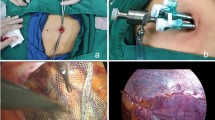Abstract
Background
Endoscopic totally extraperitoneal inguinal hernioplasty (TEP) is an accepted technique for the repair of recurrent and bilateral inguinal hernia, but its role in the management of unilateral primary inguinal hernia remains controversial. The current randomized trial was undertaken to compare the postoperative and 1-year outcomes of day-case TEP and open Lichtenstein hernioplasty for unilateral primary inguinal hernia in males.
Methods
From January 2002 to January 2004, a total of 200 male patients were randomized to undergo either day-case unilateral TEP or open Lichtenstein hernioplasty under general anesthesia. The primary outcome measures included postoperative pain score, time until return to work, incidence of chronic groin pain, and recurrence rate 1 year after the operation.
Results
All TEP procedures were successfully performed without conversion. The mean operation time for TEP (50±13.2 min) was significantly shorter than for open Lichtenstein hernioplasty (58 ± 17.6 min) (p < 0.001). The pain score at rest was significantly lower in the TEP group than in the open group on postoperative days 0, 1, 4, 5, and 6. On the average, the patients returned to work 8.6 days after TEP and 14 days after Lichtenstein hernioplasty (p = 0.006). Postoperative recovery and morbidity rates were otherwise comparable between the two groups. The incidence of chronic groin pain 1 year after TEP (9.9%) was significantly lower than after open surgery (21.7%) (p = 0.032). None of the patients in either group showed recurrence at the last follow-up assessment.
Conclusions
Day-case TEP was superior to open Lichtenstein hernioplasty for the repair of unilateral primary inguinal hernia in males. The benefits of day-case TEP included less postoperative pain, a faster return to work, and a lower incidence of chronic groin pain.



Similar content being viewed by others
References
Andersson B, Hallen M, Leveau P, Bergenfelz A, Westerdahl J (2003) Laparoscopic extraperitoneal inguinal hernia repair versus open mesh repair: a prospective randomized controlled trial. Surgery 133: 464–472
Bozuk M, Schuster R, Stewart D, Hicks K, Greaney G, Waxman K (2003) Disability and chronic pain after open mesh and laparoscopic inguinal hernia repair. Am Surg 69: 839–841
Bringman S, Ramel S, Heikkinen TJ, Englund T, Westman B, Anderberg B (2003) Tension-free inguinal hernia repair: TEP versus mesh-plug versus Lichtenstein: a prospective randomized controlled trial. Ann Surg 237: 142–147
Colak T, Akca T, Kanik A, Aydin S (2003) Randomized clinical trial comparing laparoscopic totally extraperitoneal approach with open mesh repair in inguinal hernia repair. Surg Laparosc Endosc Percutan Tech 13: 191–195
Gokalp A, Inal M, Maralcan G, Baskonus I (2003) A prospective randomized study of Lichtenstein open tension-free versus laparoscopic totally extraperitoneal techniques for inguinal hernia repair. Acta Chir Belg 103: 502–506
Grant AM, Scott NW, O’Dwyer PJ, MRC Laparoscopic Groin Hernia Trial Group (2004) Five-year follow-up of a randomized trial to assess pain and numbness after laparoscopic or open repair of groin hernia. Br J Surg 91: 1570–1574
Heikkinen T, Haukipuro K, Hulkko A (1998) A cost and outcome comparison between laparoscopic and Lichtenstein hernia operations in a day-case unit: a randomized prospective study. Surg Endosc 12: 1199–1203
Kumar S, Wilson RG, Nixon SJ, Macintyre IM (2002) Chronic pain after laparoscopic and open mesh repair of groin hernia. Br J Surg 89: 1476–1479
Lal P, Kajla RK, Chander J, Saha R, Ramteke VK (2003) Randomized controlled study of laparoscopic total extraperitoneal versus open Lichtenstein inguinal hernia repair. Surg Endosc 17: 850–856
Lau H, Lee F (2003) Seroma following endoscopic extraperitoneal inguinal hernioplasty. Surg Endosc 17: 1773–1777
Lau H, Patil NG, Yuen WK, Lee F (2002) Learning curve for unilateral endoscopic totally extraperitoneal inguinal hernioplasty. Surg Endosc 16: 1724–1728
Lau H, Patil NG, Yuen WK, Lee F (2003) Prevalence and severity of chronic groin pain following endoscopic totally extraperitoneal inguinal hernioplasty. Surg Endosc 17: 1620–1623
Lichtenstein IL, Shulman AG, Amid PK, Montllor MM (1989) The tension-free hernioplasty. Am J Surg 1989; 157: 188–193
Liem MS, van der Graaf Y, Zwart RC, Geurts I, Vroonhoven TJ (1997) A randomized comparison of physical performance following laparoscopic and open inguinal hernia repair. Br J Surg 84: 64–67
Liem MS, van Duyn EB, van der Graaf Y, van Vroonhoven TJ, Coala Trial Group (2003) Recurrences after conventional anterior and laparoscopic inguinal hernia repair: a randomized comparison. Ann Surg 237: 136–141
Mahon D, Decadt B, Rhodes M (2003) Prospective randomized trial of laparoscopic (transabdominal preperitoneal) vs open (mesh) repair for bilateral and recurrent inguinal hernia. Surg Endosc 17: 1386–1390
MRC Laparoscopic Groin Hernia Trial Group (1999) Laparoscopic versus open repair of groin hernia: a randomised comparison. Lancet 354: 185–190
Nathan JD, Pappas TN (2003) Inguinal hernia: an old condition with new solutions. Ann Surg 238: s148–s157
Neumayer L, Giobbie-Hurder A, Jonasson O, Fitzgibbons R Jr, Dunlop D, Gibbs J, Reda D, Henderson W, Veterans Affairs Cooperative Studies Program, 456 Investigators (2004) Open mesh versus laparoscopic mesh repair of inguinal hernia. N Engl J Med 350: 1819–1827
Nyhus LM (1993) Individualization of hernia repair: a new era. Surgery 114: 1–2
Acknowledgments
The authors acknowledge the kind assistance of Tze-Ching Tan, M.D., in editing the manuscript.
Author information
Authors and Affiliations
Corresponding author
Rights and permissions
About this article
Cite this article
Lau, H., Patil, N.G. & Yuen, W.K. Day-case endoscopic totally extraperitoneal inguinal hernioplasty versus open Lichtenstein hernioplasty for unilateral primary inguinal hernia in males. Surg Endosc 20, 76–81 (2006). https://doi.org/10.1007/s00464-005-0203-9
Received:
Accepted:
Published:
Issue Date:
DOI: https://doi.org/10.1007/s00464-005-0203-9




